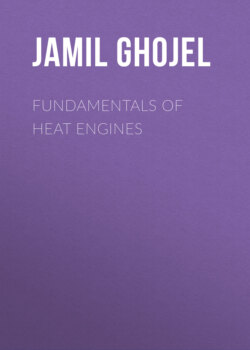Читать книгу Fundamentals of Heat Engines - Jamil Ghojel - Страница 57
1.3.5.7 Applications of the Energy Equation
ОглавлениеSimple nozzle or diffuser. A nozzle is a device that increases the velocity of a gas or vapour at the expense of pressure (Figure 1.11a). A diffuser is a device that increases the pressure of a gas or vapour at the expense of velocity (Figure 1.11b).
Figure 1.11 Schematic diagrams of a (a) nozzle; (b) diffuser.
Figure 1.12 The reciprocating internal combustion engine as a steady‐flow system.
There is no work or heat transfer and negligible potential energy change in both systems. If the input kinetic energy is of considerable value (the gas is approaching the nozzle in Figure 1.11a at a high velocity C1), the energy equation for the nozzle is
(1.75)
The kinetic energy of the fluid leaving the diffuser is usually ignored due to the low velocity at the exit, C2 (Figure 1.11b). The energy equation is then reduced to
(1.76)
Reciprocating internal combustion engine. Figure 1.12 shows a schematic diagram of the engine as a single steady‐flow system. Assuming negligible pressure work and potential and kinetic energies, energy Eq. (1.62) can be written as follows:
(1.77)
is the total heat wasted as a result of heat transfer from the hot surfaces of the engine to the surroundings.
The energy equation is often used for the combined combustion/expansion (power) stroke in reciprocating engines in order to assess the process of heat release by the burning fuel. As both inlet and exhaust valves are closed during this process, it is a non‐flow closed system with no added mechanical work. Applying the energy Eq. (1.58) written in terms of specific values, we obtain
(1.78)
Both the volume and pressure change as the gases expand in the cylinder, producing work w = ∫ pdv. There is no work addition to the process, but there is a heat loss to the surroundings (unless it is assumed that the process is adiabatic); hence, the energy equation then becomes
(1.79)
This simple and convenient form of the energy equation equates the energy input as heat from the combustion of the fuel to the sum of the change of internal energy of the gases as their temperature changes, work done by the gases as they expand in the cylinder during the power stroke, and the heat loss to the surroundings.
Gas turbine. The expansion process is steady‐state, steady‐flow with heat exchange with the surroundings and negligible potential and kinetic energy changes (Figure 1.13).
Figure 1.13 Schematic diagram of a turbine.
From Eq. (1.61)
(1.80)
If the expansion process in the turbine is adiabatic, the output power is simply
(1.81)
Air compressor. The potential energy, input heat, inlet velocity, and output mechanical work can be ignored in the case of the compressor shown in Figure 1.14. Equation (1.61) is then reduced to
(1.82)
Figure 1.14 Schematic diagram of air compressor.
If the velocity of the gas is reduced at the exit from the compressor so that the kinetic energy of discharge is negligible and there is no appreciable heat loss, Eq. (1.82) is reduced to
(1.83)
For a perfect gas, Eq. (1.83) can be written as
(1.84)
Heating gas at constant pressure or constant volume. When a gas is heated at constant volume without work or heat transfer, Eq. (1.58) is written as
(1.85a)
For a perfect gas,
(1.85b)
When the gas is heated at constant pressure under steady flow conditions, Eq. (1.60) is reduced to
(1.86)
For a perfect gas with negligible heat losses, q2 = 0 and Eq. (1.86) becomes
(1.87)
